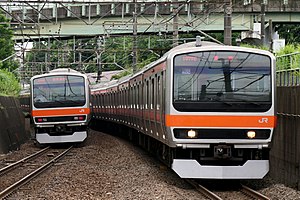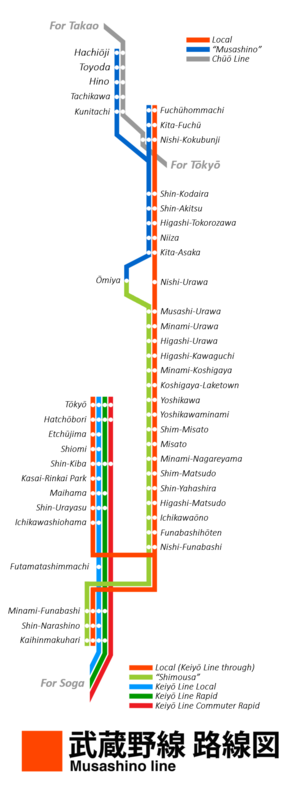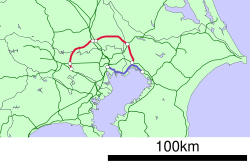Musashino Line
| Musashino Line | |||
|---|---|---|---|
| JM | |||
 Musashino Line E231 series EMUs, November 2019 | |||
| Overview | |||
| Native name | |||
| Owner | JR East | ||
| Locale | Tokyo, Kanagawa, Saitama, Chiba prefectures | ||
| Termini | |||
| Stations | 26 | ||
| Service | |||
| Type | Heavy rail | ||
| Operator(s) | |||
| Depot(s) | Keiyo | ||
| Rolling stock | 209-500 series, E231-0 series, E231-900 series EMUs | ||
| Daily ridership | 1,064,613 (daily 2015)[1] | ||
| History | |||
| Opened | 1973 | ||
| Technical | |||
| Line length | 71.8 km (44.6 mi) (passenger operations) 100.6 km (62.5 mi) (Total) | ||
| Track gauge | 1,067 mm (3 ft 6 in) | ||
| Electrification | 1,500 V DC overhead catenary | ||
| |||
The Musashino Line (
Services
[edit]Most services on the Musashino Line are local trains making all stops. Some trains continue through the Keiyō Line past Nishi-Funabashi to Tokyo, Minami-Funabashi or Kaihimmakuhari.
Other services include:
- Musashino: services operated between Fuchūhommachi/Hachiōji and Ōmiya
- Shimōsa: services operated between Ōmiya and Nishi-Funabashi/Kaihimmakuhari
- Holiday Kaisoku Kamakura seasonal service between Minami-Koshigaya and Kamakura
- Burari Kamakura and Yokohama Bay Area seasonal service between Iwaki and Kamakura
- Burari Takao Sansaku seasonal service between Hitachi and Takao
Station list
[edit]Tsurumi Station is considered to be the origin of the Musashino Line; trains going clockwise (toward Nishi-Funabashi) are therefore referred to as heading "down" (

All eastbound (for Nishi-Funabashi) passenger trains begin service at Fuchū-Hommachi Station. For details on the Musashino South Line and other branch lines, which are freight-only sections, can be found below the passenger station list.
Musashino Line (passenger)
[edit]| No. | Name | Japanese | Distance (km) | Transfers | Location | ||
|---|---|---|---|---|---|---|---|
| Between stations |
Total | ||||||
| JM35 | Fuchūhommachi | - | 0.0 | JN Nambu Line, Musashino South Line (Freight) | Fuchū | Tokyo | |
| JM34 | Kita-Fuchū | 1.7 | 1.7 | ||||
| JM33 | Nishi-Kokubunji | 2.2 | 3.9 | JC Chūō Line (Rapid) | Kokubunji | ||
| JM32 | Shin-Kodaira | 3.5 | 7.4 | Musashino Line (Kunitachi Freight Branch) |
Kodaira | ||
| JM31 | Shin-Akitsu | 5.6 | 13.0 | Higashimurayama | |||
| JM30 | Higashi-Tokorozawa | 2.7 | 15.7 | Tokorozawa | Saitama | ||
| — | Niiza Freight Terminal | 3.7 | 19.4 | Niiza | |||
| JM29 | Niiza | 0.3 | 19.7 | ||||
| JM28 | Kita-Asaka | 3.1 | 22.8 | TJ Tōbu Tōjō Line (Asakadai) | Asaka | ||
| JM27 | Nishi-Urawa | 5.0 | 27.8 | Musashino Line (Ōmiya Freight Branch) | Sakura-ku, Saitama | ||
| JM26 | Musashi-Urawa | 2.0 | 29.8 | JA Saikyō Line Musashino Line (Nishi-Urawa Freight Branch) |
Minami-ku, Saitama | ||
| JM25 | Minami-Urawa | 1.9 | 31.7 | JK Keihin-Tōhoku Line | |||
| JM24 | Higashi-Urawa | 3.7 | 35.4 | Midori-ku, Saitama | |||
| JM23 | Higashi-Kawaguchi | 3.8 | 39.2 | SR Saitama Rapid Railway Line | Kawaguchi | ||
| JM22 | Minami-Koshigaya | 4.3 | 43.5 | TS Tobu Skytree Line (Shin-Koshigaya) | Koshigaya | ||
| — | Koshigaya Freight Terminal | 0.4 | 43.9 | ||||
| JM21 | Koshigaya-Laketown | 2.4 | 46.3 | ||||
| JM20 | Yoshikawa | 1.9 | 48.2 | Yoshikawa | |||
| JM19 | Yoshikawaminami | 1.7 | 49.9 | ||||
| JM18 | Shim-Misato | 1.4 | 51.3 | Misato | |||
| JM17 | Misato | 2.1 | 53.4 | ||||
| JM16 | Minami-Nagareyama | 2.0 | 55.4 | Musashino Line (Kita-Kogane, Mabashi Freight Branches) |
Nagareyama | Chiba | |
| JM15 | Shim-Matsudo | 2.1 | 57.5 |
|
Matsudo | ||
| JM14 | Shin-Yahashira | 4.1 | 61.6 | SL Shin-Keisei Line (Yabashira) | |||
| JM13 | Higashi-Matsudo | 2.4 | 64.0 | ||||
| JM12 | Ichikawaōno | 1.9 | 65.9 | Ichikawa | |||
| JM11 | Funabashihōten | 3.0 | 68.9 | Funabashi | |||
| JM10 | Nishi-Funabashi | 2.9 | 71.8 |
| |||
Ōmekaidō Station is approximately 10 minutes walk from Shin-Kodaira Station.
Musashino Freight Branch Lines
[edit]
| Name | Japanese | Distance (km) | Transfers | Location | ||
|---|---|---|---|---|---|---|
| Between stations |
Total | |||||
| Musashino South Line | ||||||
| Tsurumi | - | 0.0 | Tōkaidō Line, Keihin Tohoku Line, Tsurumi Line, Tokaido Freight Line, Takashima Freight Line | Tsurumi-ku, Yokohama | Kanagawa | |
| Shin-Tsurumi Yard | 3.9 | 3.9 | Hinkaku Line, Nambu Line Freight Branch (for Shitte) | |||
| Kajigaya Freight Terminal | 8.8 | 12.7 | Miyamae-ku, Kawasaki | |||
| Fuchūhommachi | 16.1 | 28.8 | Musashino Line (towards Nishi-Kokubunji), Nambu Line | Fuchū | Tokyo | |
| Kunitachi Branch Line | ||||||
| Shin-Kodaira | - | 0.0 | Musashino Line (towards Nishi-Funabashi) | Kodaira | Tokyo | |
| Kunitachi | 5.0 | 5.0 | Chūō Line | Kunitachi | ||
| Omiya Branch Line | ||||||
| Nishi-Urawa | ‐ | 0.0 | Musashino Line (towards Fuchūhommachi and Tsurumi) | Sakura-ku, Saitama | Saitama | |
| Bessho Yard | 1.3 | 1.3 | ||||
| Yono | 3.6 | 4.9 | Tohoku Main Line (Tohoku Freight Line) | Urawa-ku, Saitama | ||
| Nishi-Urawa Branch Line | ||||||
| Musashi-Urawa | ‐ | ‐ | Musashino Line (towards Nishi-Funabashi) | Minami-ku, Saitama | Saitama | |
| Bessho Yard | ‐ | ‐ | Musashino Line Omiya Branch Line | |||
| Kita-Kogane Branch Line | ||||||
| Minami-Nagareyama | ‐ | 0.0 | Musashino Line (towards Fuchūhommachi and Tsurumi) | Nagareyama | Chiba | |
| Kita-Kogane | 2.9 | 2.9 | Joban Line (towards Toride) | Matsudo | ||
| Mabashi Branch Line | ||||||
| Minami-Nagareyama | ‐ | 0.0 | Musashino Line (towards Fuchūhommachi and Tsurumi) | Nagareyama | Chiba | |
| Mabashi | 3.7 | 3.7 | Joban Line (towards Mikawashima) | Matsudo | ||
Rolling stock
[edit]- 209-500 series eight-car EMUs (since December 2010)
- E231-0 series eight-car EMUs (since November 2017)
- E231-900 series eight-car EMU (since 20 July 2020)[3]
Three 209-500 series sets were transferred from the Keiyō Line in 2010-2011, where they were displaced by new E233-5000 series sets and reduced from ten to eight cars per set;[4] eight additional sets were transferred from the Chūō–Sōbu Line in 2018-2019. Between 2017 and 2020, E231-0 series sets were transferred from the Chūō–Sōbu Line and the Jōban Line and reduced from ten to eight cars per set to replace the 205 series.[5] In July 2020, the sole E231-900 series set was also transferred from the Chūō–Sōbu Line and reduced from ten to eight cars.[6]
-
A Musashino Line 209-500 series EMU in October 2019
-
A Musashino Line E231-0 series EMU in January 2023
-
Musashino Line E231-900 series in August 2022
Former
[edit]- 101-1000 series 6-car EMUs (1 April 1973 - 26 October 1986)[2]
- 103 series 6-car, later 8-car EMUs (June 1980 - 8 December 2005)[2]
- 201 series 6-car EMUs (from 3 March 1986 - November 1996)[2]
- 205-0 series 8-car EMUs (from December 1991 - October 2019)
- 205-5000 series 8-car EMUs (from 2002 - 19 October 2020)
165 and 169 series EMUs were used on Shinkansen Relay services and later Musashino rapid services until 2002. 115 series EMUs were used on Musashino services from 2002 until the services were downgraded to all-stations "Local" status in December 2010. The 205-0 series sets were built from new for the Musashino Line, entering service from 1 December 1991,[2] and have six motored cars per eight-car set.[4] These were the last 205 series sets to be built from new.[2] The 205-5000 series sets were modified between 2002 and 2008 from displaced former Yamanote Line sets by adding new VVVF-controlled AC motors, and have four motored cars per eight-car set.[4] 205 series trains, both 205-0 and 205-5000 serieses, were withdrawn from Musashino Line and currently operated in Indonesia.
-
A 101 series EMU
-
A Musashino Line 103 series (low-cab type) EMU, August 2001
-
A Musashino Line 103 series EMU, May 2002
-
A 165 series EMU (right) on a Shinkansen Relay service, August 2001
-
A 115-300 series EMU set on a Musashino service, March 2004
-
A Musashino Line 205-0 series EMU in June 2006 (this particular set is actually a 205-5000, or set 145 in Indonesia)
-
205 series EMU belonging to the Musashino Line on connecting services on the Keiyō Line, January 2010. This set is now operated in Indonesia.
Freight
[edit]Locomotive types seen hauling freight trains include the Class EF64, Class EF65, Class EF66, Class EF81, Class EF200, Class EF210, Class EH200, Class EH500, Class DE10, and Class HD300.
History
[edit]The Musashino Line was initially envisioned as a "Tokyo Outer Loop Line" in a 1927 railway appropriations bill, but was not built for several decades due to World War II and its aftermath.[citation needed] Construction finally began in November 1965.[2]
In 1967, a train carrying jet fuel to Tachikawa Air Base in western Tokyo exploded while passing through Shinjuku Station[citation needed]. This disaster led to the banning of freight trains on railway lines in central Tokyo and sped the development of the Musashino Line as an alternative route[citation needed]. Because most of the line passed through sparsely populated areas, it was initially envisioned as a freight-only line. However, opposition from local residents, at the same time as the violent landowner battles plaguing Narita International Airport, led the railway authorities to agree to passenger service as well.
The first section of the line between Fuchū-Hommachi and Shin-Matsudo opened on 1 April 1973.[4] Train services were operated using 6-car 101-1000 series EMUs, which were modified specially for the line to comply with government regulations concerning fire resistance of trains operating through long tunnels, as the line included the 4,380 m (14,370 ft) Higashi-Murayama Tunnel (
The southern freight-only line from Fuchū-Hommachi to Tsurumi opened on 1 March 1976.[4] The eastern section of the line from Shin-Matsudo to Nishi-Funabashi opened on 2 October 1978.[4]
Inter-running to and from the Keiyo Line commenced on 1 December 1988.[4]
From the start of the 1 December 1996 timetable revision, all of the Musashino Line 103 series sets were lengthened from six to eight cars.[2]
On 20 August 2016, station numbering was introduced with stations on the Musashino line being assigned station numbers between JM10 and JM35.[7][8] Numbers increase in the counter-clockwise direction towards Fuchu-Hommachi.
See also
[edit]- Osaka Higashi Line, envisioned as a counterpart in the Osaka area
- Aichi Loop Line, counterpart around Nagoya
References
[edit]- ^ "
平成 27年 大都市 交通 センサス首都 圏 報告 書 " (PDF). P.92.国土 交通 省 . - ^ a b c d e f g h i j Saka, Masayuki (August 2014).
東京 メガループ車両 ・路線 の沿革 と現況 [Tokyo Megaloop: History and current situation of trains and line]. Tetsudō Daiya Jōhō Magazine (in Japanese). Vol. 43, no. 364. Japan: Kōtsū Shimbun. pp. 28–39. - ^ "【
元 209系 】E231系 900番台 試作 車 ・MU1編成 として武蔵野線 で"再出発 "" [[Former 209 series] E231-900 series prototype train restarts on Musashino Line as MU1]. 20 July 2020. - ^ a b c d e f g
首都 圏 鉄道 完全 ガイド主要 JR路線 編 [Tokyo Area Complete Railway Guide - Major JR Lines]. Japan: Futabasha. 6 December 2013. pp. 87–97. ISBN 978-4-575-45414-7. - ^
武蔵野線 にE231系 が登場 [E231 series appears on the Musashino Line]. Japan Railfan Magazine (in Japanese). Vol. 58, no. 681. Japan: Koyusha Co., Ltd. January 2018. p. 52. - ^ "【JR
東 】E231系 元 ミツB901編成 大宮 総合 車両 センター出場 回送 " [[JR East]E231 series former set B901 exited Omiya Rolling Stock Center]. 10 July 2020. - ^ "⾸都
圏 エリアへ 「駅 ナンバリング」を導 ⼊します" [Introduce “station numbering” to the Tokyo metropolitan area] (PDF). jreast.co.jp (in Japanese). 6 April 2016. Archived from the original (PDF) on 7 December 2022. Retrieved 7 January 2023. - ^ Kusamachi, Yoshikazu (7 April 2016). "JA・JK・JT・AKB…JR
東日本 、首都 圏 で駅 ナンバリングなど導入 へ" [JA, JK, JT, AKB … JR East to introduce station numbering in the Tokyo metropolitan area]. Response Automotive Media (in Japanese). Archived from the original on 6 August 2022. Retrieved 7 January 2023.
External links
[edit]- Stations of the Musashino Line (JR East) (in Japanese)












